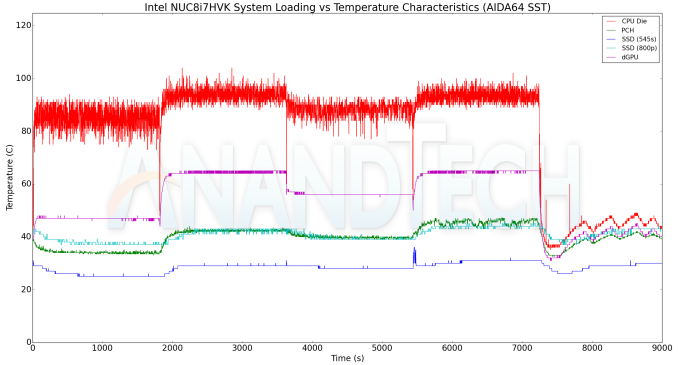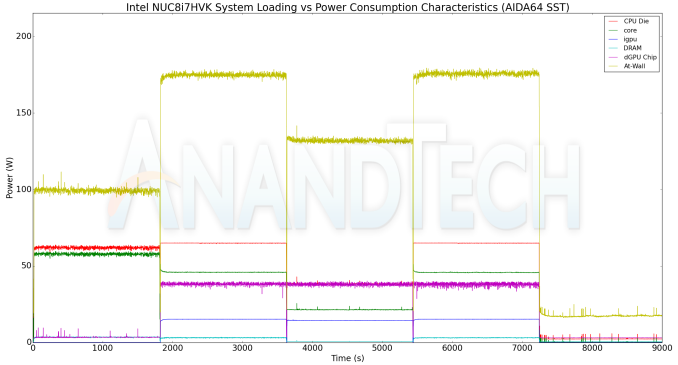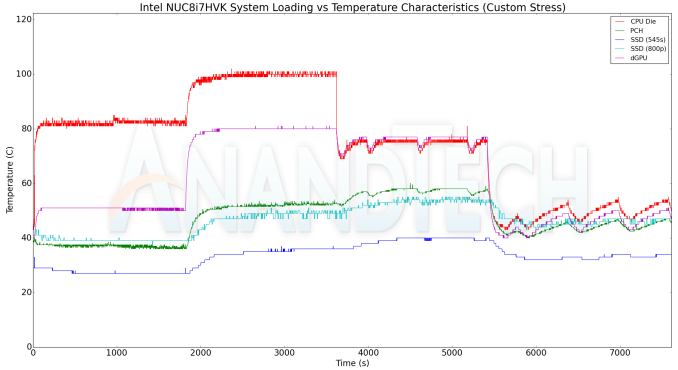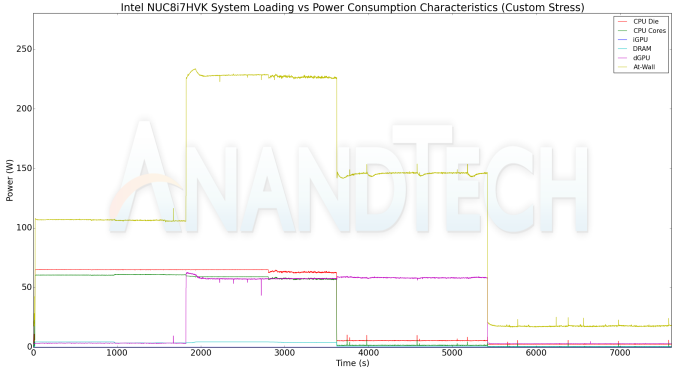The Intel NUC8i7HVK (Hades Canyon) Review: Kaby Lake-G Benchmarked
by Ganesh T S on March 29, 2018 1:00 PM ESTPower Consumption and Thermal Performance
The power consumption of the NUC8i7HVK at the wall was measured with a 4K display (LG 43UD79B) being driven through the HDMI port in the rear. In the graphs below, we compare the idle and load power of the system with other high-performance SFF PCs that we have evaluated before. For load power consumption, we ran our own custom stress test (Prime95 and FurMark) as well as the AIDA64 System Stability Test with various stress components, and noted the maximum sustained power consumption at the wall.


The power efficiency is pleasing - not only does the NUC have the lowest idle power, it also comes in the middle of the pack from a loading perspective (closer to the systems with the 65W TDP desktop processors).
Our thermal stress routine starts with the system at idle, followed by four stages of different system loading profiles using the AIDA64 System Stability Test (each of 30 minutes duration). In the first stage, we stress the CPU, caches and RAM. In the second stage, we add the GPU to the above list. In the third stage, we stress the GPU standalone. In the final stage, we stress all the system components (including the disks). Beyond this, we leave the unit idle in order to determine how quickly the various temperatures in the system can come back to normal idling range. The various clocks, temperatures and power consumption numbers for the system during the above routine are presented in the graphs below.
The cores manage to consistently stay above the rated clock (3.1 GHz) under all loading conditions. Given the higher power level (65W) that the CPU is configured for, we find that it stays close to 3.9 GHz till the CPU die starts to approach the 100C junction temperature. The thermal solution manages to easily keep the die below Tjmax while operating the cores at the rated clock.
The measurement of the power consumption presents some challenges due to the dynamic power sharing technology employed by Intel to share the package TDP across the CPU and the GPU. Currently, hardware monitoring programs are able to tap into the CPU die power (being misinterpreted as CPU package power consumption, while it actually appears to be just the CPU die power), the IA cores power (logically closer to the CPU die power, unless the iGPU is active), DRAM power consumption (refers to the SODIMMs, and not the HBM memory), and the Radeon GPU's chip power consumption. In almost all our previous system reviews, the at-wall power consumption has been close to the sum of the CPU package power and discrete GPU power (which accounting for the power consumption of the DRAM, physical disks etc.). However, in the case of the NUC8i7HVK, the at-wall power consumption is substantially higher. In the AIDA64 stress tests, we see that the CPU die power tracks the sum of the iGPU and IA cores power - around 65W, as expected. The dGPU power is only around 35W, but the maximum at-wall power consumption is as high as 175W. We are still looking into the reasons for this anomalous readings, but, it is likely that the current hardware monitoring programs are missing some key power consumption aspects of the KBL-G package.
We repeated the same observations with our legacy stress test using the latest versions of Prime95 and Furmark. Prime95 immediately pushes the core clocks to the rated speed (3.1 GHz) with infrequent spikes to 3.9 GHz, and this allows the cooling solution to maintain the CPU die at around 80C. However, adding Furmark to the mix stresses the solution, and makes it unable to prevent the die from approaching the 100C junction temperature. At that point, we see more aggressive scaling back of the cores' frequency to the rated speed.
The combination of Prime95 and Furmark makes the at-wall power consumption to go as high as 230W. However, the component power readings from the monitoring programs still show only 65W for the CPU die and around 60W for the Radeon GPU.
















124 Comments
View All Comments
zodiacfml - Friday, March 30, 2018 - link
I just like it for its integrated GPU which is a sign of good things to come.In the future, I just want to see more power from this setup. We'd see motherboards with a 6 or 8 pin connector for providing power to a more powerful GPU. Large coolers will be relevant again.
For AMD, I'd like to see them make a similar setup but with the HBM memory accessible for both the CPU and GPU.
What would Jesus Do? - Saturday, March 31, 2018 - link
Test comment test!!!santiagodraco - Saturday, March 31, 2018 - link
Can't play back UHD Blu-Ray? Wow. Intel you just lost a significant portion of the potential market for this pos. Why would anyone in their right minds buy this over say an Nvidia Shield, or hell a Shield + an Xbox X + a PS4 Pro... for the same money or less.Time to fire some folks in management.
santiagodraco - Saturday, March 31, 2018 - link
Not to mention the price once you add an SSD and memory. My god, what are they thinking? This thing is an utter joke! You could build a far far better system without much more of a footprint than this hunk of junk, for less. Just mind boggling. I thought that after the fiasco with the original Skull Canyon that Intel would have learned something... but instead they went backwards. I can hear them now "Let's make it less capable and cost 1/3 to 2x more than the previous version....people will love it!"Hifihedgehog - Monday, April 2, 2018 - link
The hilarious thing is AMD’s Raven Ridge, which has Video Core Next (unlike its other Vega brethren), can properly decode UHD Blu-ray content and VP9 with fixed function decoding. Excluding gaming, AMD did end up giving Intel the second-rate goods after all. I am using a 2400G in a Streacom FC8 and VCN’s decoding quality is such a revelation that I now strictly use MadVR for UHD Blu-ray and HDR->SDR conversion.medi03 - Saturday, March 31, 2018 - link
And the reason not include 1060 / 1050 in the benchmarks is?bill44 - Saturday, March 31, 2018 - link
What a mess.Who can recommend a HTPC I can purchase or build that supports the following:
Stereo 3D - BD 3D ISO frame packed support (without issues) over HDMI 2.x (before you reply, please red Intel's official reply from this thread https://communities.intel.com/thread/112109?start=...
HDMI 2.x output that supports 176.4KHz, 88.2KHz as well was the usual 44KHz & 192KHz without resampling. As far as I know, NVidia can't do it. Reviews of GPUs do not include AUDIO specification or AUDIO testing anymore, only GAME GAME GAME!
Apart from picture/movie/streaming, I would like to use my HTPC to play Hi-Res music back without resampling.
UHD-BD playback - requires protected video/audio path, SGX, firmware & software support etc.
That's it. Just 3 requirements. Intel iGPU is out, NVidia is out, maybe AMD?
bill44 - Saturday, March 31, 2018 - link
Just one more thing: Displayport 1.2 only? I thought AMD supports 1.3/1.4.Hifihedgehog - Monday, April 2, 2018 - link
The 2400G actually works for HDMI 2.0 with current gen hardware. I just built an HTPC in a Streacom FC8 and Raven Ridge, which exclusively has Video Core Next (not even discrete Vega has this), has the best hardware video decoding I have ever used, bar none. See here for compatibility information :smallformfactor (dot) net/forum/threads/raven-ridge-hdmi-2-0-compatibility-1st-gen-am4-motherboard-test-request-megathread.6709/
Hifihedgehog - Monday, April 2, 2018 - link
PS: Raven Ridge Vega’s VCN has fixed function VP9 decoding without restrictions. Prior revisions of Vega, including the revision on the Intel CPU+dGPU multi-die packages, use the old UVD system which, while considered by most videophiles to be the best hardware decoding option in terms of decoding quality compared to NVIDIA and AMD (see here: forums (dot) anandtech (dot) com/threads/does-anyone-review-video-decoding-quality-any-more.2410025/#post-36936833 ; despite being from 2014, this old post still pretty much applies), still lacks fixed function VP9 hardware support.